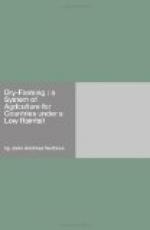Under conditions of water scarcity it is often found profitable to carry water to the garden in cement or iron pipes so that no water may be lost by seepage or evaporation during the conveyance of the water from the reservoir to the garden. It is also often desirable to convey water to plants through pipes laid under the ground, perforated at various intervals to allow the water to escape and soak into the soil in the neighborhood of the plant roots. All such refined methods of irrigation should be carefully investigated by the who wants the largest results from his limited water supply. Though such methods may seem cumbersome and expensive at first, yet they will be found, if properly arranged, to be almost automatic in their operation and also very profitable.
Forbes has reported a most interesting experiment dealing with the economical use of a small water supply under the long season and intense water dissipating conditions of Arizona. The source of supply was a well, 90 feet deep. A 3 by 14-inch pump cylinder operated by a 12-foot geared windmill lifted the water into a 5000-gallon storage reservoir standing on a support 18 feet high. The water was conveyed from this reservoir through black iron pipes buried 1 or 2 feet from the trees to be watered. Small holes in the pipe 332 inch in diameter allowed the water to escape at desirable intervals. This irrigation plant was under expert observation for considerable time, and it was found to furnish sufficient water for domestic use for one household, and irrigated in addition 61 olive trees, 2 cottonwoods, 8 pepper trees, 1 date palm, 19 pomegranates, 4 grapevines, 1 fig tree, 9 eucalyptus trees, 1 ash, and 13 miscellancous, making a total of 87 useful trees, mainly fruit-bearing, and 32 vines and bushes. (See Fig. 95.) If such a result can be obtained with a windmill and with water ninety feet below the surface under the arid conditions of Arizona, there should be little difficulty in securing sufficient water over the larger portions of the dry-farm territory to make possible beautiful homesteads.




